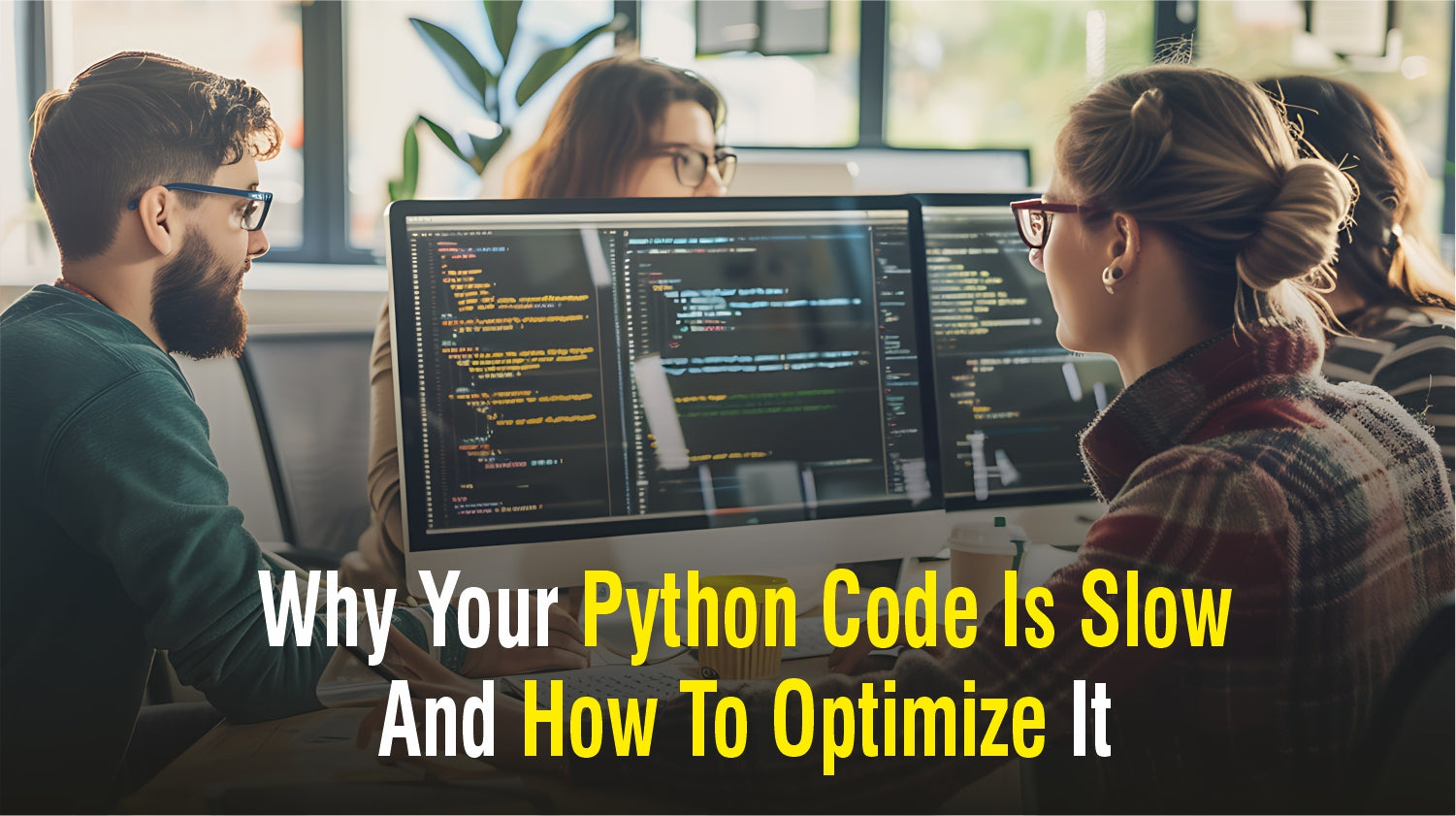Blogs On Programming

Why Your Python Code Is Slow And How To Optimize It
on Sep 22 2025
You’ve learned Python. You can write functions, use loops, and build small projects. Maybe you’re analyzing data or automating tasks at work. You’ve stopped second-guessing every line of code and started thinking in a more “Pythonic” way. You finally feel worthy of the title programmer.
But then it happens.
You write a script that feels smooth and elegant. No errors, no warnings, no issues. That is, until you run it on real data—and it grinds to a halt.
When Code Works—But Doesn’t Scale
As beginner programmers, we usually test our code with small inputs. Let’s say you’re writing a script to check for duplicate charges in your bank account. A common early solution is a nested for loop that compares each transaction to every other transaction by vendor, date, and amount.
This brute force approach works. But it’s inefficient.
With 10 transactions, your program performs 100 comparisons. With 20, it jumps to 400. At 1,000? Now you're looking at a million comparisons. Your program hasn’t broken—your approach just doesn’t scale.
This is a pivotal moment in every programmer’s journey: realizing that correct code isn’t enough. It has to be efficient.
Enter: Algorithmic Complexity
Most beginner tutorials focus on writing code that works, not code that works well. The inefficiencies are hidden by the speed of modern machines—until they aren’t. Once you’re comfortable with basic syntax, it’s time to learn about scalability and performance.
Algorithm complexity is typically broken into two parts:
Time complexity: How the runtime grows as input size increases.
Space complexity: How memory usage grows with input size.
Of the two, time complexity is usually the first wall intermediate programmers hit. When considering time complexity, it is not important to actually time our programs. We are not concerned with how long the program takes to run, but rather how the time changes as the input grows.
Time complexity is typically written in Big O notation. You may remember function notation from math class, where we would write f(n) to indicate a function. Big O notation uses O(n) where the “n” is the input size. You may see other variables used to indicate other factors as well. Some common time complexities are:
Understanding how input size impacts performance is key to writing scalable code.
Back to our bank example: the nested loop approach results in O(n²) time complexity. That’s fine for 10 transactions—but terrible for 10,000.
Scaling Smarter: From Brute Force to Sets
So how do we reduce complexity? We rethink the problem.Do we need to compare every transaction to every other one? Absolutely not. What we really want to know is whether the same vendor, date, and amount appear more than once.While there are many different ways to do this, a set would allow us to complete this simple task.Here’s the approach:
Start with an empty set.
Loop through each transaction.
Store each as a tuple (vendor, date, amount).
If it’s already in the set, it’s a duplicate.If not, add it to the set.
Sets in Python are highly optimized, with the average lookup being constant, or O(1). And because there’s only one loop, the total time complexity drops to O(n). This allows the program to be much more scalable.
The Tradeoff: Time vs. Space
Improving time performance often comes with a tradeoff: increased memory use.Our nested loop didn’t store any intermediate data, so its space complexity was O(1)—constant. In contrast, our set-based approach stores a unique record for each transaction, so space complexity becomes O(n)—linear.That might sound like a step backward. But on modern hardware, linear memory usage is rarely a concern. The performance gain in time complexity is far more valuable.Just be cautious of anything that grows faster than linear in space—quadratic or exponential memory usage can quickly overwhelm any system.
Build Code That Scales
By stepping back and thinking about complexity, you can write code that’s not only correct, but also scalable. That’s what separates scripts that break under pressure from ones that power real-world applications.So yes, celebrate when your Python code works. But then ask: will it still work when the input grows?That’s the mindset that turns a programmer into a software engineer.
Want to Go Deeper?
If you found this helpful and want to truly build the foundation for scalable, high-performance code, check out my book: Data Structures and Algorithms Essentials You Always Wanted to Know.
It’s written with clarity for intermediate programmers and packed with practical examples, real-world use cases, and the kind of insights that unlock better problem-solving. Whether you're preparing for interviews or simply ready to level up your coding game, this book will help you understand how and why to write code that performs under pressure.
This blog is written by Shawn Peters, author of Data Structures and Algorithms Essentials You Always Wanted to Know.
Galley cover of Data Structures and Algorithms Essentials You Always Wanted to Know by Vibrant Publishers.
Also read:AI Can Code, So Do You Still Need to Learn Programming?Demystifying Machine Learning: A Practical Guide for BeginnersThe Power of Data Visualization: Bringing Data to Life

AI Can Code, So Do You Still Need to Learn Programming?
on Dec 12 2024
With the rise of generative AI technology, investing time in learning to program might seem strange. The advancements in AI technology are impressive. From autocompleting code to identifying bugs, it may seem like there is no longer a place for a programmer. After all, with a simple prompt, AI can generate complete programs much quicker than a novice programmer could ever hope to do so.
Generative AI is a valuable tool that enhances the programming workflow in many ways.
Code Autocompletion: Typos and misspellings are the bane of many programmers. AI tools can predict and suggest code snippets reducing the likelihood of syntax errors and inaccurate variable and function names.
Code Generation from Descriptions: AI can rapidly prototype code based on a description of what is needed. While this shouldn’t be used as the final code, using it as a boilerplate can speed up development.
Bug Detection: While Python gives great feedback on errors, there will be times when a programmer is left hunting for a bug with no cause in sight. AI can quickly analyze code to identify syntax errors, and sometimes even logical errors. Add to this the ability to suggest fixes, and you’ve got an invaluable tool.
Documentation Generation: Good documentation is important for understanding and managing code, but it is an extra step that doesn’t always get the full attention it deserves. Thankfully AI tools can automatically generate documentation by analyzing code, although it would still need reviewing.
While AI tools enhance productivity, they lack the understanding and creativity of human programmers.
Despite its capabilities, it is important to understand that generative AI also has limitations.
Limited Creativity
While AI excels at routine tasks, it lacks the ability to think outside the box. Models like GPT-4 are trained from data pulled from the internet, so that code can be easily generated for problems that have already been solved. While AI seems to solve complex problems, it is often piecing together several similar problems or following established patterns. AI lacks comprehension and cannot synthesize new solutions. On the other hand, human insight and creativity can truly solve novel problems.
Misinterpretation of Context
While AI is getting better at understanding the context of a request, there is no replacement for human judgment. Nuanced or ambiguous scenarios can be misunderstood by AI, leading to a code that does not fit the requirements of the project. This can lead to situations where there is more work fixing and refining AI code than just writing it.
Inconsistent Quality
Programmers tend to have what could be called a coding accent. In the same way that people have consistency in the way they speak and write, programmers tend to have a coding style. AI pulls from various sources, so the exact output of the code can be unpredictable, leading to an inconsistent style. Worse than this, the code produced is of varying quality, sometimes written with best practices in mind, and other times written barely functional. Programmers still need to be involved to review the code and ensure it integrates with complex systems.
Ethical and Security Risks
An AI tool is only as good as the data it was trained on. Much of the code on the internet is not written with security in mind or may not consider security threats older than the training data. Without critically evaluating AI-generated code, vulnerabilities could be introduced into code bases which could put sensitive data at risk.
Conclusion
When it comes to programming, a balanced approach to generative AI is important. AI tools can enhance productivity by automating mundane tasks and offering enhanced debugging, but they lack the understanding and creativity that programmers have at their disposal. Programming skills will still be required for now and well into the future.
Book cover of Python Essentials You Always Wanted To Know- a quintessential guide to begin your coding journey.
Python Essentials You Always Wanted to Know is the perfect resource to begin your programming journey. This book guides you through fundamental coding concepts, supplemented with practical examples and case studies, helping you to apply what you have learned seamlessly. Due to Python’s versatility and active community, its applications in data science, automation, and machine learning have become indispensable. With its growing demand, now is the perfect time to level up your coding skills with Python.
This blog is written by Shawn Peters, author of Python Essentials You Always Wanted To Know.
Find out more about the book here: Link to the book: Python Essentials You Always Wanted To KnowAuthor: Shawn PetersPress Release: Vibrant Publishers’ New Release is a Game-Changer for Professional Growth
Also read:Want to stand out for your Upcoming Python Interview?Data Structures & Algorithms Interview Q/A that can land you into your dream jobDeep Dive into Java Operators

5 Reasons Why You (Yes You!) Should Learn Python
on Oct 08 2024
Introduction
Whether you're just starting your career or nearing its end, one undeniable truth remains: the professional landscape we navigate today vastly differs from what it was just a decade ago. Think about the tools you use daily, many of them didn't exist five or ten years ago. In this rapidly evolving digital world, the ability to adapt and thrive is more critical than ever, especially in the era of AI, blockchain, and augmented reality.
Enter Python – a programming language renowned for its simplicity, versatility, and robust ecosystem. Originally favored by developers, Python has now become indispensable across various industries and professions. While it's no surprise that Python dominates fields like data science, analytics, and web development, its influence now extends to finance, healthcare, education, and beyond.
Python's popularity stems from its user-friendly syntax and extensive libraries, making it an ideal starting point for beginners venturing into the world of programming. Its readability and simplicity allow newcomers to easily grasp fundamental concepts, laying a solid foundation for further learning and skill development.
Consider that both of these programs take in two integer values and print out their sum. The Python program on the left is certainly easier to understand than the Java program on the right.
Python's easy-to-read syntax makes it a preferred language for professionals from various fields.
With Python as your starting point, you'll embark on a journey of discovery and growth, equipped with a powerful toolset to navigate the ever-evolving landscape of modern technology.
Here are five compelling reasons why learning Python can supercharge your professional journey:
1 - Automating Repetitive Tasks
In any profession, some tasks are necessary but dreadfully mundane. Whether it's managing emails, organizing files, or generating reports, these repetitive chores can drain your time and energy. Python comes to the rescue with its powerful automation capabilities. You can streamline workflows with Python scripts, saving time and minimizing errors. Python's versatility extends beyond your local environment, enabling you to automate tedious tasks effortlessly.
2 - Analyzing and Visualizing Data
In today's data-driven world, Python plays a pivotal role in extracting valuable insights from vast datasets. Its intuitive syntax and rich toolkit enable professionals to efficiently clean, transform, and analyze data of all sizes and complexities. Python offers a variety of visualization options, from simple charts to complex plots, empowering users to represent data in an insightful manner.
3 - Enhancing Teamwork and Efficiency
Python serves as a catalyst for enhancing collaboration and productivity within organizations. Through custom solutions and frameworks, Python enables streamlined communication and project management. Whether it's developing web applications or implementing chatbots for automated support, Python fosters teamwork and efficiency.
4 - Embracing Modern Solutions
Python stands as a leading force in modern technology, providing adaptable solutions designed for the current digital environment. Its simplicity and flexibility render it a prime candidate for emerging technologies, including the Internet of Things (IoT) - a network of interconnected devices that communicate and share data to perform tasks more efficiently. In practical terms, professionals can utilize Python to create IoT solutions for various industries, such as smart home automation, industrial monitoring, and healthcare device integration. Python's user-friendly nature and vast libraries streamline the development process, allowing for rapid prototyping and deployment of IoT applications.
5 - Engaging in Personalized Professional Development
Python opens doors to a world of opportunities for personalized growth and exploration. Whether you're interested in data analysis, web development, or machine learning, Python offers a versatile platform for showcasing your skills and pursuing your passions. Its vibrant open-source community encourages collaboration and innovation, while certifications and specializations provide avenues for advancing your career.
Conclusion
With Python as your toolkit, you're not merely a passive consumer of technology – you have the power to become a proactive creator, shaping the future of your profession and driving innovation forward.
Galley cover of Python Essentials You Always Wanted To Know - a beginner’s guide to learning and mastering Python.
For those looking to embark on this journey, Python Essentials You Always Wanted to Know is the perfect resource. This comprehensive guide breaks down complex concepts into manageable, easy-to-understand chapters, helping you to master Python one step at a time. With Python as your starting point, you will embark on a journey of discovery and growth, equipped with a powerful toolset to navigate the ever-evolving landscape of modern technology.
Also read:Want to stand out for your Upcoming Python Interview?Data Structures & Algorithms Interview Q/A that can land you into your dream jobDeep Dive into Java Operators

